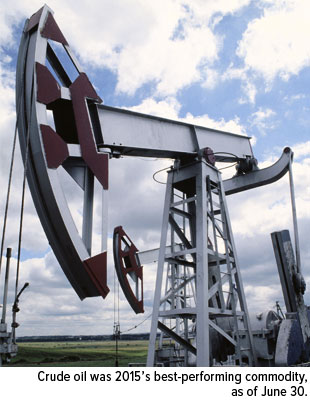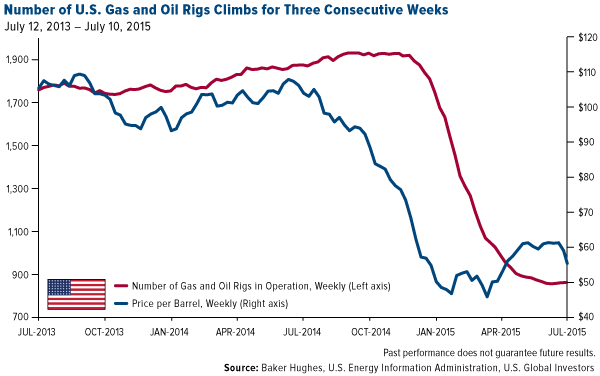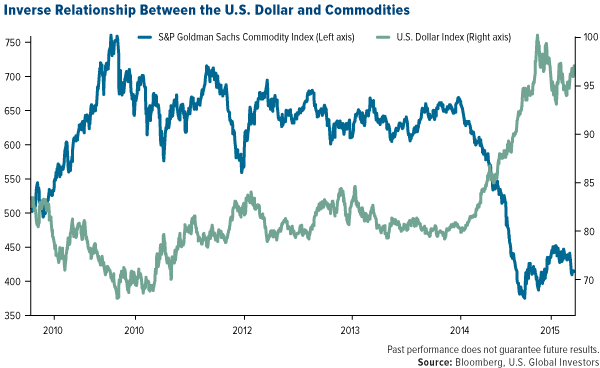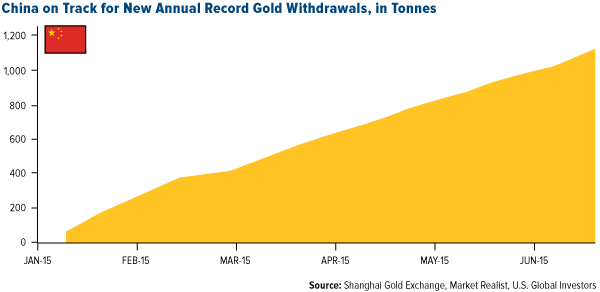Can we really be halfway through the year? That’s what my calendar tells me, which means it’s time for the 2015 commodities halftime report.
The periodic table of commodity returns, consistently one of our most popular pieces, has been updated to reflect the first half of 2015.
As an asset class, commodities continue to be a challenging space for investors, as they’ve faced many headwinds lately, including lackluster purchasing managers’ index (PMI) numbers and a strong U.S. dollar.
Crude Pulls off Coup but Faces Strong Downward Pressure
The widest expansion this year was made by none other than crude oil, the worst-performing commodity of 2014. As of June 30, oil posted gains of over 11 percent, rising to $59.47 per barrel. After falling more than 50 percent since last summer, though, it had nowhere else to go but up. That oil claimed the top spot just highlights the reality that commodities are in a slump right now. 
Case in point: This week, West Texas Intermediate (WTI) retreated to $50 per barrel, putting it back in the red for the year. This move was largely in response to Greece’s debt dilemma, China’s slowdown and weakening PMI numbers. After the JPMorgan (NYSE:JPM) Global Manufacturing and Services PMI was released, showing a continued downtrend in manufacturing activity, oil almost immediately dropped $4. The lifting of sanctions on Iran, if approved by Congress, could also place downward pressure on WTI, with some analysts seeing it returning to the $40s range.
As the 800-pound commodity gorilla, China greatly contributes to the performance of oil. Its own PMI reading remains below the key 50 threshold, indicating that its manufacturing sector is in contraction mode. This has a huge effect on the consumption of oil and other important commodities.
The good news is that the projected crude price for the remainder of 2015 should be high enough to support continued production in drilling areas such as the Bakken, Eagle Ford and Permian basins, according to the Energy Information Administration (EIA). The oil rig count, as reported by Baker Hughes (NYSE:BHI), has advanced for the third consecutive week, after 29 straight weeks of declines. 
King Corn Pops to the Top
We all know that corn is in practically everything we eat and drink, from soda to bread to salad dressing. It’s fed to livestock and poultry and used to make ethanol, plastic, glue and more. The grain is so ingrained in our lives that the U.S. government subsidizes it to the tune of $4.5 billion a year.
For this reason and more, American farmers favor corn. In 2013, a record amount of it was grown and sent to market, which resulted in a price decline of 40 percent. That year, it was the worst-performing commodity.
Since then, corn has found its footing and, as of June 30, returned 4.28 percent.
Zinc Is Flying off Car Lots
Sought for its anti-corrosive properties, zinc is staging a comeback and is set to make its longest run of gains in over a year, according to Mineweb.

The reason? Accelerating automobile sales in Europe. Zinc can be found in most car parts, from tires to door handles, and because it can store six times more energy per pound than more conventional battery systems, the metal is also used in electric vehicles.
The European Automobile Manufacturers Association reports that demand for new vehicles is up 14 percent year-over-year in June, its largest increase since December 2009. New car registrations in most European markets are seeing double-digit growth, with Portugal, Spain, Ireland and the Czech Republic leading the pack.
Gold Demand in China Sparkles
In a much-anticipated announcement, China broke its six-year silence on the amount of gold its central bank holds. And although the number jumped nearly 60 percent from 1,054 tonnes in 2009 to 1,658 tonnes, it underwhelmed the market, as many analysts had expected almost double the amount. Bullion fell to a fresh five-year low on Friday, while stock in Barrick Gold (NYSE:ABX), the world’s largest producer, plunged to a level not seen since the Bush Administration—the elder Bush, that is.
But other news out of China, the largest purchaser of gold, suggests that the yellow metal is still very much on consumers’ minds. Just-released gold withdrawal numbers from the Shanghai Gold Exchange (SGE) came in at 1,180 tonnes—a huge amount—setting a new record for withdrawals in the first half period and leading many analysts to predict a new annual record.
Gold demand in China normally cools around this time before picking up momentum in anticipation of the Chinese New Year. That demand has held up so well is a good sign for the second half of the year.
Morningstar Ratings are based on risk-adjusted return.
The Morningstar Rating for a fund is derived from a weighted-average of the performance figures associated with its three-, five- and ten-year Morningstar Rating metrics. Past performance does not guarantee future results. For each fund with at least a three-year history, Morningstar calculates a Morningstar Rating based on a Morningstar Risk-Adjusted Return measure that accounts for variation in a fund’s monthly performance (including the effects of sales charges, loads, and redemption fees), placing more emphasis on downward variations and rewarding consistent performance. The top 10% of funds in each category receive 5 stars, the next 22.5% receive 4 stars, the next 35% receive 3 stars, the next 22.5% receive 2 stars and the bottom 10% receive 1 star. (Each share class is counted as a fraction of one fund within this scale and rated separately, which may cause slight variations in the distribution percentages.)
Gold, precious metals, and precious minerals funds may be susceptible to adverse economic, political or regulatory developments due to concentrating in a single theme. The prices of gold, precious metals, and precious minerals are subject to substantial price fluctuations over short periods of time and may be affected by unpredicted international monetary and political policies. We suggest investing no more than 5% to 10% of your portfolio in these sectors.
The S&P GSCI Spot index tracks the price of the nearby futures contracts for a basket of commodities.
The J.P. Morgan Global Purchasing Manager’s Index is an indicator of the economic health of the global manufacturing sector. The PMI index is based on five major indicators: new orders, inventory levels, production, supplier deliveries and the employment environment.
The U.S. Trade Weighted Dollar Index provides a general indication of the international value of the U.S. dollar.
Fund portfolios are actively managed, and holdings may change daily. Holdings are reported as of the most recent quarter-end. Holdings in the Gold and Precious Metals Fund as a percentage of net assets as of 6/30/2015: Baker Hughes Inc. 0.00%, Barrick Gold Corp. 0.03%.
Disclaimer: All opinions expressed and data provided are subject to change without notice. Some of these opinions may not be appropriate to every investor. By clicking the link(s) above, you will be directed to a third-party website(s). U.S. Global Investors does not endorse all information supplied by this/these website(s) and is not responsible for its/their content.



